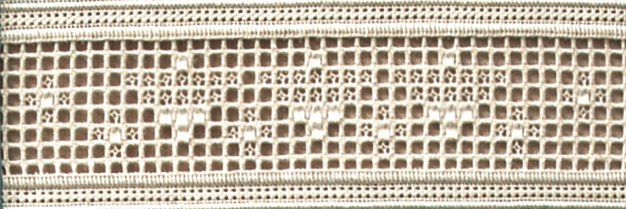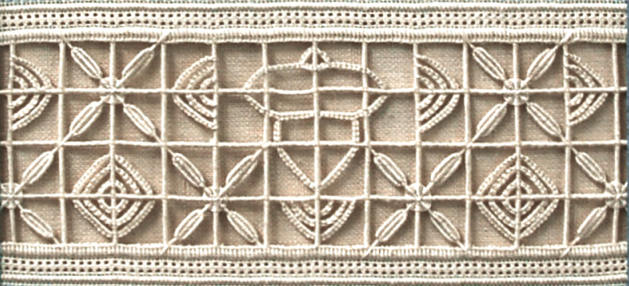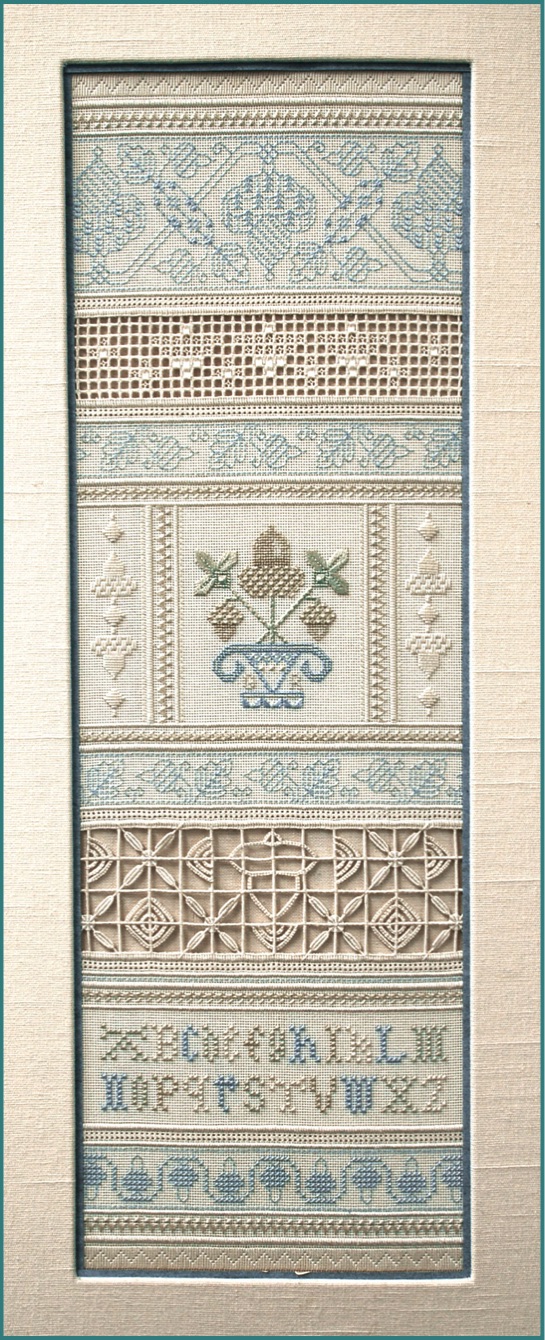Acorn Sampler, History
A band sampler of traditional bands of acorns. If you look carefully, you will see that there are acorns in each major bands except the alphabet band.
Starting from the top, the bands are of Double Running Stitch, a traditional drawn thread technique, more Double Running Stitch, the center of a 'bouquet' of acorns, more Double Running Stitch, Reticella, an alphabet and Cross Stitch.
A non-stitching friend once asked me if I had any idea why acorns appear on so much historical needlework. Obviously for the symbolism, but I think there is another reason: they lend themselves to needlework so well, and in so many forms.
Acorn Sampler, Notes on the Various Techniques
My history with Double Running Stitch began with this sampler. Betty Chen Louis taught me how to do it, and we started with the large band of acorns at the top of the sampler. I had charted it from a traditional sampler in the Victoria and Albert Museum and she showed me how to make the pattern reversible.
I had been doing cutwork for quite a while by the time I stitched this sampler and I was becoming a bit more innovative with it, hence the appearance of the acorns in the drawn thread pattern at the top and the Reticella toward the bottom.
I have used this alphabet a number of times as I find it so interesting. At one EGA seminar I bought a wonderful second edition of Marcus Huish's book on samplers and according to the book, this alphabet is the oldest he knew of on samplers. If you have not seen his book and you are interested in samplers, the book has often been reprinted.
At the bottom of the sampler I did some Cross Stitch acorns. They are one of the few times I have done traditional Cross Stitch over 2 meshes. I use a lot of Cross Stitch here and there but almost always over 1 mesh.
On the left are some closeups of the various bands
Acorn Sampler
A Long Band Sampler from My Travel-Teaching Days
Scroll down for notes and some closeups of this traditional band sampler.




Acorn Sampler, Using Historical Patterns
I do like to use historical patterns but I prefer not to remain too true to them. I like to fiddle with them, so that they are a reflection on the past but they also are a part of my own needlework life.
There are two prominent people whose writings reflect this and I often quoted them in my teaching days. These two are Joan Edwards and Carol Humphrey.
The gist of their arguments is the same: that the art of the sampler lives on only if we make it a reflection of our own time.
I love to borrow from old samplers, but I like to dream up what to do with a foundation of the past but a bit of innovation that belongs in the present.
This sampler is perhaps the most traditional I ever stitched.
Acorn Sampler
Instructions only
(no canvas, no threads).
$78.00 includes shipping and insurance.
To Pay by PayPal click on the button:
Acorn Sampler Descriptions
I am offering the instructions only, no canvas, no threads.
The supplies I used for Acorn Sampler include 5 colors of Soie d'Alger and 2 balls each of pearl cotton #8 and #12. I used ecru pearl cotton on ecru congress cloth 11" x 24".
Yes, a linen ground will work, although I would avoid a flimsy wiggly linen, as a ground fabric with more body will help your tension. If I were to make the sampler again, I would consider linen congress cloth of which Cathe Ray at Needle in a Haystack has a stash. Lucky Cathe!
I do not recommend this sampler for the inexperienced stitcher. The techniques, while not quite as difficult as the ones on my Drawn Thread Sampler, are dependent on good control of tension, and as most of us experienced stitchers know, good tension takes time, patience and experience.
The instructions are 77 pages long, with 8 Oversize Graphs and a color copy of my finished sampler.
Notes on Pearl Cotton
Poor Pearl Cotton, for many years my go-to thread, has such an undeserved reputation as a rather nasty thread for beginners only. Not so in my own life: chances are, if you see a kit of mine where the dominant thread is pearl cotton, you are likely looking at one of my more difficult designs.
Scroll down for descriptions

EWeek is CLOSED
